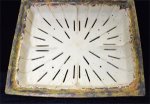Paradox
Imperial Masterpiece
Paradox, anderson tray & colanders ARE a vast improvement on the ancient bonsai pot designs. Welcome to air pruning, superior drainage & superior root aeration
First I am not new to air pruning. I use containers very much like colanders as training pots. They work fine but I also use pots with solid sides and they also work fine. I have not seen one difference or advantage of on over the other whatsoever.
We are talking about 2 different things.
An Anderson flat is used as training pot and it has solid sides and a mesh bottom, I would not consider it the same as a colander or similar that has holes on the side.
The the pot you posted in the first picture and the title of the thread asks about BONSAI pots which is different from a training pot.
Scott, I totally disagree with you. Good drainage & aeration starts with the pot. Soil comes later. Making fast draining soil is good but to put that into pots having poor drainage & aeration just seems like taking 1 step forward and 1 step backwards.
Scott is absolutely correct. You can put as many holes in the pot that you want, if the soil does not drain it doesnt matter one iota.
Here is a scots pine that I have had for 5 years. This picture was taken in 2012.

See the pot it is in? Exactly what you are talking about right?
However there is window screen lining the inside of the pot and the soil is a mixture of sand and gravel.
The bottom of the pot has several 3/8 inch holes for drainage. Being sand, the soil always drained pretty fast when I watered.
The tree was repotted from its nursery container to that pot in the spring of 2012.
The tree did ok. It grew some but wasnt extremely vigorous.
Fast forward to March 2016.
I repotted the tree into a shallow, plastic bonsai shaped training pot with a mixture of sifted lava, pumice, akadama, gravel and charcoal.
When I took it out of the sand and gravel, I noted that in 4 years there had been very little root growth. There was some but certainly not what I would expect after 4 years.

I put moss over the soil to help it retain a bit more moisture. I find the mix to dry out very quickly when it is new. I removed the moss in September.
Note: This training pot has a lot less holes than the old training pot.
Here is what I noticed when I removed the moss.
The tree went absolutely nuts with root growth. There were new roots everywhere.
The tree's branches had bulked up on wood to the point where one branch almost doubled in thickness.
So the tree went from a pot with more holes and a sand mix to a pot with less holes and a larger sized (about 1/4" inch) soil mix.
I have no doubt that the response I got from the tree has everything to do with the change in soil, not the change in the pot.
Ive seen similar results just by changing the soil and keeping the same pot as in the first picture.



